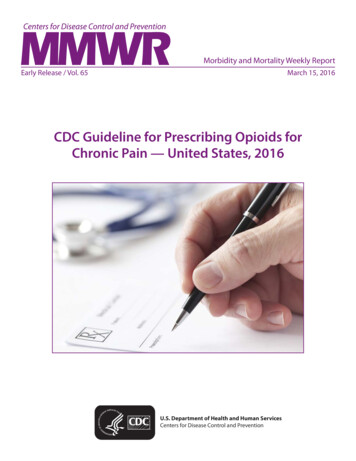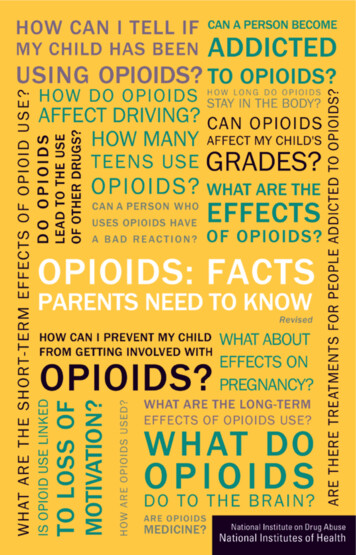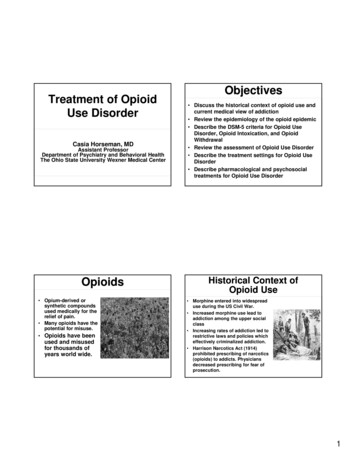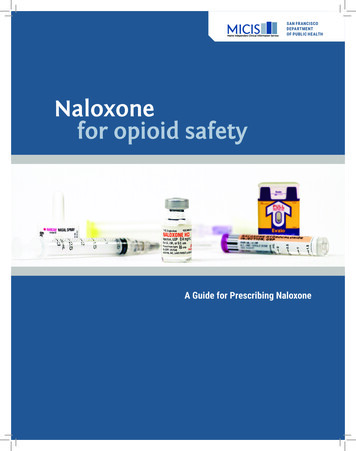
Transcription
Morbidity and Mortality Weekly ReportEarly Release / Vol. 65March 15, 2016CDC Guideline for Prescribing Opioids forChronic Pain — United States, 2016U.S. Department of Health and Human ServicesCenters for Disease Control and Prevention
Early ReleaseCONTENTSIntroduction.1Guideline Development Methods.4Summary of the Clinical Evidence Review.8Summary of the Contextual Evidence Review. 11Recommendations. 16Conclusions and Future Directions. 33References. 35Disclosure of RelationshipThe Core Expert Group (CEG) members disclose that they have no financial conflictsof interest. Experts disclose the following activities related to the content of thisguideline: Pam Archer discloses authorship of the Oklahoma Emergency Departmentand Urgent Care Clinic Opioid Prescribing Guidelines and the Opioid PrescribingGuidelines for Oklahoma Health Care Providers in the Office Based Setting; BonnieBurman discloses authorship of the Ohio Guidelines for Prescribing Opioids for theTreatment of Chronic, Non-Terminal Pain; Jane Ballantyne discloses that she hasserved as a paid consultant to Cohen Milstein Sellers & Toll, PLLC, and has specialadvisory committee responsibilities on the Food and Drug Administration (FDA)Risk Evaluation and Mitigation Strategies committee; Phillip Coffin discloses that in2012 he provided expert testimony to the California State Assembly regarding a bill toexpand naloxone access and reports that he is the principal investigator on a researchstudy of methamphetamine dependence that receives donated injectable naltrexonefrom Alkermes, Inc.; Gary Franklin discloses authorship of the AMDG InteragencyGuideline on Prescribing Opioids for Pain; Erin Krebs discloses that she representedthe American College of Physicians at a 2014 Food and Drug Administrationmeeting on Abuse Deterrent Opioid Formulations; Lewis Nelson discloses his ad-hocmembership on the FDA Drug Safety and Risk Management Advisory Committee;Trupti Patel discloses authorship of the Arizona Opioid Prescribing Guidelines; Robert“Chuck” Rich discloses that he was an author of the 2013 American Academy ofFamily Physicians position paper on opioids and pain management; Joanna Starrelsdiscloses that she received honoraria from the Betty Ford Institute; Thomas Tapediscloses that he was an author of the 2013 American College of Physicians policyposition paper on prescription drug abuse. CDC provided 100% of the fundingfor the supplemental evidence review tasks and meeting support. No foundation orindustry support was accepted.The Opioid Guideline Workgroup (OGW) members disclose that they have nofinancial conflicts of interest. Experts disclose the following activities related to thecontent of this guideline: Anne Burns discloses that she participated in a congressionalbriefing sponsored by Reps. Carter and DeSaulnier on the pharmacist’s role offurnishing Naloxone and that she participates on the National Advisory Board for thePrescription Drug Abuse and Heroin Summit. Chinazo Cunningham discloses thather husband is employed by Quest Diagnostics and Dr. Cunningham was recusedfrom any discussion related to urine drug testing. Traci Green discloses that she waspreviously employed by Inflexxion, a small business that conducts Small BusinessInnovation Research on behavioral interventions for behavioral health and chronic painand created several psychometric tools for conducting risk assessment for prescriptionopioid abuse potential. Dr. Green also discloses that while at the hospital where sheis employed, she provided consultation to Purdue Pharma Ltd to design overdoseprevention brochures for persons who use diverted prescription opioids non-medicallywith an emphasis on persons who inject prescription drugs, and not for patients usingopioid therapy for pain. Dr. Green was recused from any discussion related to riskassessment tools and patient education materials. Erin Krebs discloses that she servedon the CDC Opioid Prescribing Guideline CEG. Christina Porucznik discloses thatshe served on the CDC Opioid Prescribing Guideline CEG. Greg Terman disclosesthat he serves as the President of the American Pain Society. Mark Wallace disclosesthat he served on a Kempharma advisory panel for an abuse-deterrent hydrocodoneformulation to treat acute postoperative pain and Dr. Wallace was recused form anydiscussion related to abuse-deterrent drugs.The NCIPC Board of Scientific Counselors (BSC) members disclose that theyhave no financial conflicts of interest. Two BSC members, Traci Green and ChristinaPorucznik, served on the Opioid Guideline Workgroup. Traci Green discloses thatshe was previously employed by Inflexxion, a small business that conducts SmallBusiness Innovation Research on behavioral interventions for behavioral health andchronic pain and created several psychometric tools for conducting risk assessmentfor prescription opioid abuse potential. Dr. Green also discloses that while at thehospital where she is employed, she provided consultation to Purdue Pharma Ltdto design overdose prevention brochures for persons who use diverted prescriptionopioids non-medically with an emphasis on persons who inject prescription drugs,and not for patients using opioid therapy for pain. Dr. Green was recused from anydiscussion related to risk assessment tools and patient education materials. ChristinaPorucznik discloses that she served on the CDC Opioid Prescribing Guideline CEG.The MMWR series of publications is published by the Center for Surveillance, Epidemiology, and Laboratory Services, Centers for Disease Control and Prevention (CDC),U.S. Department of Health and Human Services, Atlanta, GA 30329-4027.Suggested citation: [Author names; first three, then et al., if more than six.] [Title]. MMWR Recomm Rep 2016;65(No. RR-#):[inclusive page numbers].Centers for Disease Control and PreventionThomas R. Frieden, MD, MPH, DirectorHarold W. Jaffe, MD, MA, Associate Director for ScienceJoanne Cono, MD, ScM, Director, Office of Science QualityChesley L. Richards, MD, MPH, Deputy Director for Public Health Scientific ServicesMichael F. Iademarco, MD, MPH, Director, Center for Surveillance, Epidemiology, and Laboratory ServicesMMWR Editorial and Production Staff (Serials)Sonja A. Rasmussen, MD, MS, Editor-in-ChiefCharlotte K. Kent, PhD, MPH, Executive EditorChristine G. Casey, MD, EditorTeresa F. Rutledge, Managing EditorDavid C. Johnson, Lead Technical Writer-EditorJeffrey D. Sokolow, MA, Project EditorMartha F. Boyd, Lead Visual Information SpecialistMaureen A. Leahy, Julia C. Martinroe,Stephen R. Spriggs, Moua Yang, Tong Yang,Visual Information SpecialistsQuang M. Doan, MBA,Phyllis H. King, Terraye M. Starr,Information Technology SpecialistsMMWR Editorial BoardTimothy F. Jones, MD, ChairmanMatthew L. Boulton, MD, MPHVirginia A. Caine, MDKatherine Lyon Daniel, PhDJonathan E. Fielding, MD, MPH, MBADavid W. Fleming, MDWilliam E. Halperin, MD, DrPH, MPHKing K. Holmes, MD, PhDRobin Ikeda, MD, MPHRima F. Khabbaz, MDPhyllis Meadows, PhD, MSN, RNJewel Mullen, MD, MPH, MPAJeff Niederdeppe, PhDPatricia Quinlisk, MD, MPHPatrick L. Remington, MD, MPHCarlos Roig, MS, MAWilliam L. Roper, MD, MPHWilliam Schaffner, MD
Early ReleaseCDC Guideline for Prescribing Opioids for Chronic Pain —United States, 2016Prepared byDeborah Dowell, MD1Tamara M. Haegerich, PhD1Roger Chou, MD11Division of Unintentional Injury Prevention, National Center for Injury Prevention and Control, CDC, Atlanta, GeorgiaSummaryThis guideline provides recommendations for primary care clinicians who are prescribing opioids for chronic pain outside ofactive cancer treatment, palliative care, and end-of-life care. The guideline addresses 1) when to initiate or continue opioids forchronic pain; 2) opioid selection, dosage, duration, follow-up, and discontinuation; and 3) assessing risk and addressing harmsof opioid use. CDC developed the guideline using the Grading of Recommendations Assessment, Development, and Evaluation(GRADE) framework, and recommendations are made on the basis of a systematic review of the scientific evidence while consideringbenefits and harms, values and preferences, and resource allocation. CDC obtained input from experts, stakeholders, the public,peer reviewers, and a federally chartered advisory committee. It is important that patients receive appropriate pain treatmentwith careful consideration of the benefits and risks of treatment options. This guideline is intended to improve communicationbetween clinicians and patients about the risks and benefits of opioid therapy for chronic pain, improve the safety and effectivenessof pain treatment, and reduce the risks associated with long-term opioid therapy, including opioid use disorder, overdose, anddeath. CDC has provided a checklist for prescribing opioids for chronic pain (http://stacks.cdc.gov/view/cdc/38025) as well as awebsite ces.html) with additional tools to guide clinicians in implementingthe recommendations.IntroductionBackgroundOpioids are commonly prescribed for pain. An estimated20% of patients presenting to physician offices with noncancerpain symptoms or pain-related diagnoses (including acuteand chronic pain) receive an opioid prescription (1). In 2012,health care providers wrote 259 million prescriptions for opioidpain medication, enough for every adult in the United Statesto have a bottle of pills (2). Opioid prescriptions per capitaincreased 7.3% from 2007 to 2012, with opioid prescribingrates increasing more for family practice, general practice, andinternal medicine compared with other specialties (3). Rates ofopioid prescribing vary greatly across states in ways that cannotbe explained by the underlying health status of the population,highlighting the lack of consensus among clinicians on howto use opioid pain medication (2).Prevention, assessment, and treatment of chronic pain arechallenges for health providers and systems. Pain might gounrecognized, and patients, particularly members of racialand ethnic minority groups, women, the elderly, persons withCorresponding author: Deborah Dowell, Division of UnintentionalInjury Prevention, National Center for Injury Prevention and Control,CDC. E-mail: gdo7@cdc.gov.cognitive impairment, and those with cancer and at the end oflife, can be at risk for inadequate pain treatment (4). Patientscan experience persistent pain that is not well controlled. Thereare clinical, psychological, and social consequences associatedwith chronic pain including limitations in complex activities,lost work productivity, reduced quality of life, and stigma,emphasizing the importance of appropriate and compassionatepatient care (4). Patients should receive appropriate paintreatment based on a careful consideration of the benefits andrisks of treatment options.Chronic pain has been variably defined but is definedwithin this guideline as pain that typically lasts 3 months orpast the time of normal tissue healing (5). Chronic pain canbe the result of an underlying medical disease or condition,injury, medical treatment, inflammation, or an unknown cause(4). Estimates of the prevalence of chronic pain vary, but itis clear that the number of persons experiencing chronic painin the United States is substantial. The 1999–2002 NationalHealth and Nutrition Examination Survey estimated that14.6% of adults have current widespread or localized painlasting at least 3 months (6). Based on a survey conductedduring 2001–2003 (7), the overall prevalence of common,predominantly musculoskeletal pain conditions (e.g., arthritis,rheumatism, chronic back or neck problems, and frequentsevere headaches) was estimated at 43% among adults in theUS Department of Health and Human Services/Centers for Disease Control and PreventionMMWR / March 15, 2016 / Vol. 651
Early ReleaseUnited States, although minimum duration of symptoms wasnot specified. Most recently, analysis of data from the 2012National Health Interview Study showed that 11.2% of adultsreport having daily pain (8). Clinicians should consider thefull range of therapeutic options for the treatment of chronicpain. However, it is hard to estimate the number of personswho could potentially benefit from opioid pain medicationlong term. Evidence supports short-term efficacy of opioidsfor reducing pain and improving function in noncancernociceptive and neuropathic pain in randomized clinical trialslasting primarily 12 weeks (9,10), and patients receivingopioid therapy for chronic pain report some pain relief whensurveyed (11–13). However, few studies have been conductedto rigorously assess the long-term benefits of opioids for chronicpain (pain lasting 3 months) with outcomes examined at least1 year later (14). On the basis of data available from healthsystems, researchers estimate that 9.6–11.5 million adults, orapproximately 3%–4% of the adult U.S. population, wereprescribed long-term opioid therapy in 2005 (15).Opioid pain medication use presents serious risks, includingoverdose and opioid use disorder. From 1999 to 2014, morethan 165,000 persons died from overdose related to opioidpain medication in the United States (16). In the past decade,while the death rates for the top leading causes of death suchas heart disease and cancer have decreased substantially, thedeath rate associated with opioid pain medication has increasedmarkedly (17). Sales of opioid pain medication have increasedin parallel with opioid-related overdose deaths (18). The DrugAbuse Warning Network estimated that 420,000 emergencydepartment visits were related to the misuse or abuse of narcoticpain relievers in 2011, the most recent year for which dataare available (19). Although clinical criteria have varied overtime, opioid use disorder is a problematic pattern of opioiduse leading to clinically significant impairment or distress. Thisdisorder is manifested by specific criteria such as unsuccessfulefforts to cut down or control use and use resulting in socialproblems and a failure to fulfill major role obligations at work,school, or home (20). This diagnosis has also been referred toas “abuse or dependence” and “addiction” in the literature,and is different from tolerance (diminished response to adrug with repeated use) and physical dependence (adaptationto a drug that produces symptoms of withdrawal when thedrug is stopped), both of which can exist without a diagnoseddisorder. In 2013, on the basis of DSM-IV diagnosis criteria,an estimated 1.9 million persons abused or were dependent onprescription opioid pain medication (21). Having a history ofa prescription for an opioid pain medication increases the riskfor overdose and opioid use disorder (22–24), highlighting thevalue of guidance on safer prescribing practices for clinicians.For example, a recent study of patients aged 15–64 years2MMWR / March 15, 2016 / Vol. 65receiving opioids for chronic noncancer pain and followedfor up to 13 years revealed that one in 550 patients died fromopioid-related overdose at a median of 2.6 years from their firstopioid prescription, and one in 32 patients who escalated toopioid dosages 200 morphine milligram equivalents (MME)died from opioid-related overdose (25).This guideline provides recommendations for the prescribingof opioid pain medication by primary care clinicians forchronic pain (i.e., pain conditions that typically last 3 monthsor past the time of normal tissue healing) in outpatient settingsoutside of active cancer treatment, palliative care, and endof-life care. Although the guideline does not focus broadlyon pain management, appropriate use of long-term opioidtherapy must be considered within the context of all painmanagement strategies (including nonopioid pain medicationsand nonpharmacologic treatments). CDC’s recommendationsare made on the basis of a systematic review of the best availableevidence, along with input from experts, and further reviewand deliberation by a federally chartered advisory committee.The guideline is intended to ensure that clinicians and patientsconsider safer and more effective treatment, improve patientoutcomes such as reduced pain and improved function,and reduce the number of persons who develop opioid usedisorder, overdose, or experience other adverse events relatedto these drugs. Clinical decision making should be basedon a relationship between the clinician and patient, and anunderstanding of the patient’s clinical situation, functioning,and life context. The recommendations in the guideline arevoluntary, rather than prescriptive standards. They are basedon emerging evidence, including observational studies orrandomized clinical trials with notable limitations. Cliniciansshould consider the circumstances and unique needs of eachpatient when providing care.RationalePrimary care clinicians report having concerns about opioidpain medication misuse, find managing patients with chronicpain stressful, express concern about patient addiction, andreport insufficient training in prescribing opioids (26). Acrossspecialties, physicians believe that opioid pain medication canbe effective in controlling pain, that addiction is a commonconsequence of prolonged use, and that long-term opioidtherapy often is overprescribed for patients with chronicnoncancer pain (27). These attitudes and beliefs, combinedwith increasing trends in opioid-related overdose, underscorethe need for better clinician guidance on opioid prescribing.Clinical practice guidelines focused on prescribing can improveclinician knowledge, change prescribing practices (28), andultimately benefit patient health.US Department of Health and Human Services/Centers for Disease Control and Prevention
Early ReleaseProfessional organizations, states, and federal agencies(e.g., the American Pain Society/American Academy of PainMedicine, 2009; the Washington Agency Medical DirectorsGroup, 2015; and the U.S. Department of Veterans Affairs/Department of Defense, 2010) have developed guidelines foropioid prescribing (29–31). Existing guidelines share somecommon elements, including dosing thresholds, cautioustitration, and risk mitigation strategies such as using riskassessment tools, treatment agreements, and urine drugtesting. However, there is considerable variability in thespecific recommendations (e.g., range of dosing thresholds of90 MME/day to 200 MME/day), audience (e.g., primary careclinicians versus specialists), use of evidence (e.g., systematicreview, grading of evidence and recommendations, and role ofexpert opinion), and rigor of methods for addressing conflictof interest (32). Most guidelines, especially those that are notbased on evidence from scientific studies published in 2010or later, also do not reflect the most recent scientific evidenceabout risks related to opioid dosage.This CDC guideline offers clarity on recommendationsbased on the most recent scientific evidence, informed byexpert opinion and stakeholder and public input. Scientificresearch has identified high-risk prescribing practices thathave contributed to the overdose epidemic (e.g., highdose prescribing, overlapping opioid and benzodiazepineprescriptions, and extended-release/long-acting [ER/LA]opioids for acute pain) (24,33,34). Using guidelines to addressproblematic prescribing has the potential to optimize care andimprove patient safety based on evidence-based practice (28),as well as reverse the cycle of opioid pain medication misusethat contributes to the opioid overdose epidemic.Scope and AudienceThis guideline is intended for primary care clinicians (e.g.,family physicians and internists) who are treating patientswith chronic pain (i.e., pain lasting 3 months or pastthe time of normal tissue healing) in outpatient settings.Prescriptions by primary care clinicians account for nearlyhalf of all dispensed opioid prescriptions, and the growthin prescribing rates among these clinicians has been aboveaverage (3). Primary care clinicians include physicians as wellas nurse practitioners and physician assistants. Although thefocus is on primary care clinicians, because clinicians workwithin team-based care, the recommendations refer to andpromote integrated pain management and collaborativeworking relationships with other providers (e.g., behavioralhealth providers, pharmacists, and pain managementspecialists). Although the transition from use of opioidtherapy for acute pain to use for chronic pain is hard to predictand identify, the guideline is intended to inform clinicianswho are considering prescribing opioid pain medication forpainful conditions that can or have become chronic.This guideline is intended to apply to patients aged 18 yearswith chronic pain outside of palliative and end-of-life care. Forthis guideline, palliative care is defined in a manner consistentwith that of the Institute of Medicine as care that provides relieffrom pain and other symptoms, supports quality of life, andis focused on patients with serious advanced illness. Palliativecare can begin early in the course of treatment for any seriousillness that requires excellent management of pain or otherdistressing symptoms (35). End-of-life care is defined as carefor persons with a terminal illness or at high risk for dyingin the near future in hospice care, hospitals, long-term caresettings, or at home. Patients within the scope of this guidelineinclude cancer survivors with chronic pain who have completedcancer treatment, are in clinical remission, and are under cancersurveillance only. The guideline is not intended for patientsundergoing active cancer treatment, palliative care, or endof-life care because of the unique therapeutic goals, ethicalconsiderations, opportunities for medical supervision, andbalance of risks and benefits with opioid therapy in such care.The recommendations address the use of opioid painmedication in certain special populations (e.g., older adultsand pregnant women) and in populations with conditionsposing special risks (e.g., a history of substance use disorder).The recommendations do not address the use of opioidpain medication in children or adolescents aged 18 years.The available evidence concerning the benefits and harmsof long-term opioid therapy in children and adolescents islimited, and few opioid medications provide informationon the label regarding safety and effectiveness in pediatricpatients. However, observational research shows significantincreases in opioid prescriptions for pediatric populations from2001 to 2010 (36), and a large proportion of adolescents arecommonly prescribed opioid pain medications for conditionssuch as headache and sports injuries (e.g., in one study, 50% ofadolescents presenting with headache received a prescriptionfor an opioid pain medication [37,38]). Adolescents whomisuse opioid pain medication often misuse medications fromtheir own previous prescriptions (39), with an estimated 20%of adolescents with currently prescribed opioid medicationsreporting using them intentionally to get high or increase theeffects of alcohol or other drugs (40). Use of prescribed opioidpain medication before high school graduation is associatedwith a 33% increase in the risk of later opioid misuse (41).Misuse of opioid pain medications in adolescence stronglypredicts later onset of heroin use (42). Thus, risk of opioidmedication use in pediatric populations is of great concern.Additional clinical trial and observational research is needed,US Department of Health and Human Services/Centers for Disease Control and PreventionMMWR / March 15, 2016 / Vol. 653
Early Releaseand encouraged, to inform development of future guidelinesfor this critical population.The recommendations are not intended to provide guidanceon use of opioids as part of medication-assisted treatment foropioid use disorder. Some of the recommendations might berelevant for acute care settings or other specialists, such asemergency physicians or dentists, but use in these settings orby other specialists is not the focus of this guideline. Readersare referred to other sources for prescribing recommendationswithin acute care settings and in dental practice, such as theAmerican College of Emergency Physicians’ guideline forprescribing of opioids in the emergency department (43); theAmerican Society of Anesthesiologists’ guideline for acute painmanagement in the perioperative setting (44); the WashingtonAgency Medical Directors’ Group Interagency Guideline onPrescribing Opioids for Pain, Part II: Prescribing Opioids inthe Acute and Subacute Phase (30); and the PennsylvaniaGuidelines on the Use of Opioids in Dental Practice (45).In addition, given the challenges of managing the painfulcomplications of sickle cell disease, readers are referred to theNIH National Heart, Lung, and Blood Institute’s EvidenceBased Management of Sickle Cell Disease Expert Panel Reportfor management of sickle cell disease (46).Guideline Development MethodsGuideline Development Using the Gradingof Recommendations Assessment,Development, and Evaluation MethodCDC developed this guideline using the Grading ofRecommendations Assessment, Development, and Evaluation(GRADE) method (http://www.gradeworkinggroup.org). Thismethod specifies the systematic review of scientific evidenceand offers a transparent approach to grading quality of evidenceand strength of recommendations. The method has beenadapted by the CDC Advisory Committee on ImmunizationPractices (ACIP) (47). CDC has applied the ACIP translationof the GRADE framework in this guideline. Within the ACIPGRADE framework, the body of evidence is categorizedin a hierarchy. This hierarchy reflects degree of confidencein the effect of a clinical action on health outcomes. Thecategories include type 1 evidence (randomized clinical trialsor overwhelming evidence from observational studies), type 2evidence (randomized clinical trials with important limitations,or exceptionally strong evidence from observational studies),type 3 evidence (observational studies or randomized clinicaltrials with notable limitations), and type 4 evidence (clinical4MMWR / March 15, 2016 / Vol. 65experience and observations, observational studies withimportant limitations, or randomized clinical trials with severalmajor limitations). Type of evidence is categorized by studydesign as well as limitations in study design or implementation,imprecision of estimates, variability in findings, indirectnessof evidence, publication bias, magnitude of treatment effects,dose-response gradient, and a constellation of plausible biasesthat could change observations of effects. Type 1 evidenceindicates that one can be very confident that the true effectlies close to that of the estimate of the effect; type 2 evidencemeans that the true effect is likely to be close to the estimateof the effect, but there is a possibility that it is substantiallydifferent; type 3 evidence means that confidence in the effectestimate is limited and the true effect might be substantiallydifferent from the estimate of the effect; and type 4 evidenceindicates that one has very little confidence in the effectestimate, and the true effect is likely to be substantially differentfrom the estimate of the effect (47,48). When no studies arepresent, evidence is considered to be insufficient. The ACIPGRADE framework places recommendations in two categories,Category A and Category B. Four major factors determinethe category of the recommendation: the quality of evidence,the balance between desirable and undesirable effects, valuesand preferences, and resource allocation (cost). Category Arecommendations apply to all persons in a specified group andindicate that most patients should receive the recommendedcourse of action. Category B recommendations indicate thatthere should be individual decision making; different choiceswill be appropriate for different patients, so clinicians musthelp patients arrive at a decision consistent with patientvalues and preferences, and specific clinical situations (47).According to the GRADE methodology, a particular qualityof evidence does not necessarily imply a particular strengthof recommendation (48–50). Category A recommendationscan be made based on type 3 or type 4 evidence whenthe advantages of a clinical action greatly outweigh thedisadvantages based on a consideration of benefits and harms,values and preferences, and costs. Category B recommendationsare made when the advantages and disadvantages of aclinical action are more balanced. GRADE methodology isdiscussed extensively elsewhere (47,51). The U.S. PreventiveServices Task Force (USPSTF) follows different methods fordeveloping and categorizing recommendations (http://www.uspreventiveservicestaskforce.org). USPSTF recommendationsfocus on preventive services and are categorized as A, B, C, D,and I. Under the Affordable Care Act, all “nongrandfathered”health plans (that is, those health plans not in existence priorto March 23, 2010 or those with significant changes to theircoverage) and expanded Medicaid plans are required to coverUS Department of Health and Human Services/Centers for Disease Control and Prevention
Early Releasepreventive services recommended by USPSTF with a categoryA or B rating with no cost sharing. The coverage requirementswent into effect September 23, 2010. Similar requirements arein place for vaccinations recommended by ACIP, but do notexist for other recommendations made by CDC, includingrecommendations within this guideline.A
rates increasing more for family practice, general practice, and internal medicine compared with other specialties (3). Rates of opioid prescribing vary greatly across states in ways that cannot be explained by the underlying health status of the population, highlighting the lack of consensus among clinicians on how to use opioid pain .










